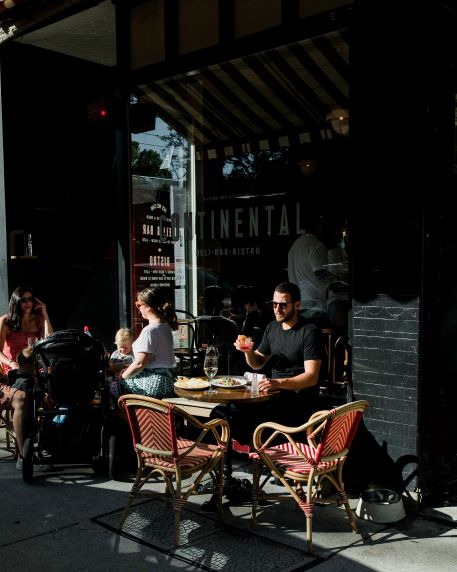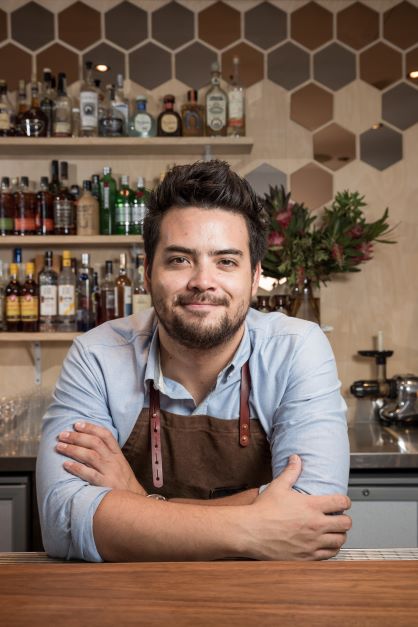Whether you like it or not, the cosmopolitan is a modern classic. Its creation signalled a new chapter in the cocktail world, with bartenders using fresh citrus juice and interactive garnishes instead of artificial flavourings and umbrellas. Although the cosmo was an ‘it’ drink in its heyday, the cocktail fell flat in the face of spritzes and Negronis. But it’s remerged this year and there’s a revival on the cards.
Hospitality talks to Continental Deli’s Michael Nicolian and Proof and Company’s Charlie Ainsbury about the cosmo’s peak era, their recipes and techniques to getting it right and why it’s making a comeback.
The cosmopolitan was created in the mid ’80s by Miami bartender Cheryl Cook who was asked by Absolut Vodka to create a drink that would ‘appeal to women’. Cook’s take was based off a kamikaze and a lemon drop, with the early version combining the newly launched Absolut Citron with triple sec, Rose’s lime cordial and cranberry juice.
But the cocktail didn’t gain traction until the late ’90s which saw Rainbow Room Bartender Dale DeGroff replace the lime cordial with fresh lime juice and add a flamed orange twist. It was a game-changer for the drink, which quickly sprung up on menus and stayed on them well into the early aughts.
According to Continental Deli Co-Owner Michael Nicolian, Dale DeGroff’s theatrical style of bartending put the cosmopolitan on the map, and it became the go-to drink for celebrities and the public alike. “It was in the papers and DeGroff made it fun and cool being the showman he is with the flamed orange zest,” says Nicolian. “He had a lot of famous people like Madonna drinking it and Sex and the City had a massive influence on the drink’s popularity and fame.”
The ’70s and ’80 are a mostly grim time for cocktails, but the cosmopolitan changed the trajectory and prompted bartenders to experiment with real ingredients. “We consider it the dark ages for cocktails because it was just absolutely terrible; no good drinks came out,” says Proof and Company’s Senior Bar Consultant Charlie Ainsbury. “But then came Dale DeGroff, who used fresh lime juice and it kicked off what we call the second golden age of fine drinking. Before that, it was all artificial ingredients and fake syrups; there was no love and care put into what bartenders were doing.”

The ingredients in a cosmopolitan include vodka, cranberry juice, triple sec and fresh lime juice. While spirits are interchangeable when it comes to brands (Absolut Vodka and Cointreau are the most reached for), harmony is critical, especially when working with ingredients that aren’t the norm. “Some people like to use citrus vodka and some use plain,” says Nicolian. “What matters more is thinking about the balance.”
Achieving the desired colour is also make or break, otherwise it’s not a cosmopolitan. “It shouldn’t be red; if a cosmo is red, send it back,” says Ainsbury. “It just has to have a little dash of cranberry juice to give it a nice pink hue.”
When it comes to making the drink: it’s as simple as it gets. “Throw it all in a shaker, shake until cold and strain into a cocktail glass,” says Ainsbury.
Traditionally, a cosmopolitan can be finished off with a wedge of lime, but Ainsbury prefers the more elaborate option of a flamed piece of orange. “You take a little coin of pith from the orange and you express the flammable oils of the orange over a match and spray it onto the drink,” he says. “You’ve got yourself a really interactive garnish that provides aroma and gets the bar talking.”
At Continental Deli in Sydney, the Cosmopoli-tin is part of the canned cocktail range. The recipe sees a slight adjustment to accommodate the packaging. “Because we’re canning them, we don’t use lime juice as we don’t want perishables in the can,” says Nicolian. “With the dry element and sharpness, we infuse dry cranberries with pinot sherry and use that to balance out the sweetness of the triple sec, which works pretty well.”

Continental Deli plans to tweak their current canned cosmo by adding an orange element in a nod to DeGroff. “We’re incorporating the flamed orange you get from a Dale DeGroff garnish,” says Nicolian. “We’re sticking cloves in a whole orange and infusing it to create depth of flavour.” But when he’s not making cosmos for canning purposes, Nicolian always uses fresh citrus juice.
Cosmopolitans have been drowned out in a sea of margaritas and gin-centric cocktails for some time, but they’re poised to make a comeback. The cocktail has long been a favourite for Nicolian, who has nostalgic ties to the drink. “My brother (who was my first boss in the bar industry) taught me how to make a cosmo and he was like, ‘It’s pretty much the perfect drink; it’s dry and boozy, fruitful and tangy’,” he says. “It hits a lot of styles in one, and when it’s made well, it comes together beautifully.”
Despite the cosmopolitan’s dwindling popularity in recent years, the cocktail is indisputably recognisable. “People love familiarity,” says Nicolian. “Even if they’ve never had a cosmopolitan or a martini, when they see it in a can with a little pun they go, ‘I know that, I’ve seen it on TV before; I’ll get it’. And if it’s made well, even better; they’ll get another one.”

Ainsbury predicts the cosmopolitan of 2021 and beyond will utilise current bartending techniques and showcase ingredients that are recognisable to a modern market. “To appeal to guests, bartenders use familiar cocktail names but serve the drinks using a different method,” he says. “Whether that’s clarification, a fermented cosmo or using native red fruits to get the pink hue. Maybe they’re using native gins instead of vodka. Bartenders take the base cosmo recipe and present it as a cosmopolitan in order to introduce drinkers to the current climate. A cosmopolitan falls into the category of a daisy, which is a formula or a family of cocktails with a spirit, a flavoured liqueur and a citrus element. There are about six or seven families of cocktails, and if you know the foundations, you can riff off anything.”
The cosmopolitan may not have the same clout it did during its peak, but it generates a sense of nostalgia. For Nicolian and Ainsbury, the cocktail generates comfort and an opportunity to modernise an iconic drink. “People who turned their nose up at drinks like mojitos, cosmos and dirty martinis 10 years ago would be ridiculed for doing so now,” says Nicolian. “These drinks are making a comeback because people are more comfortable drinking them.”
If recent signs are anything to go by, the cosmo is stepping out from behind the bar and back onto menus. “I’m sure someone right now is drinking a cosmopolitan, whether it’s well made or not,” says Ainsbury. “It’s one of those drinks you have to know. It’s a stayer; simple as that.”
Image Credit: Cookidoo
Sponsored Content

The future of reusables in the hospitality industry
Sponsored by Huskee

The premium deep frying oil trusted by William Angliss
Sponsored by Peerless
Trending Now
Resources
Lorem ipsum dolor sit amet, consectetur adipiscing elit. Fusce ac ornare lectus. Sed bibendum lobortis...
Lorem ipsum dolor sit amet, consectetur adipiscing elit. Fusce ac ornare lectus. Sed bibendum lobortis...
Sign up for our newsletter
